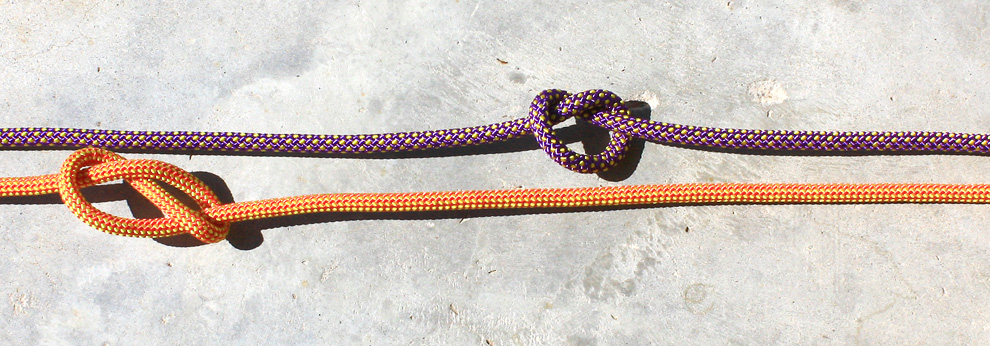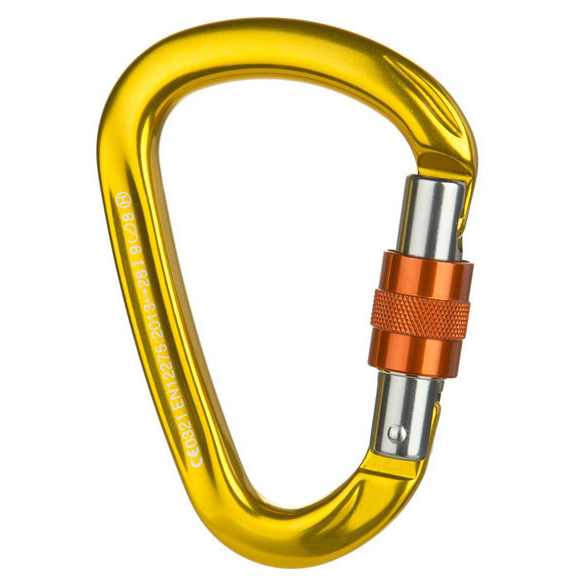Simple Canyoneering Knots: The Overhand and Figure Eight Knots
"To me the simple act of tying a knot is an adventure in unlimited space. A bit of string provides a dimensional latitude that is unique among the entities." ~Clifford W. Ashley, The Ashley Book of Knots, page 8. In this lesson, we'll look at knot terminology and learn how to tie the overhand and figure eight knots, with a few variations.
To begin our foray into canyoneering knots, we start with basic knotting nomenclature. Knotting is done with a piece of cord, webbing or perhaps cloth, but the material makes but little difference in the process. We will refer to "cord" or "rope" as general terms.
NOMENCLATURE
The four parts of a piece of cord, of interest, are the END, a BIGHT, a LOOP and the STANDING PART. The END is, of course, where the rope stops being rope and becomes air. Most ropes will have TWO ends—ones that do not should be considered suspect. A BIGHT is a tight fold of the rope, used like an end to tie a knot. Such a knot is termed “on a bight”—for instance, an “Overhand on a Bight”. However, not all knots are tied the same way “on a bight” as they are tied “on an end”. A LOOP is like a bight, but with a half-twist to make a CROSSING. Ends or bights can be put into loops to make knots. A LOOP can also be called a CROSSING or a SINGLE TURN.The STANDING PART of the rope is the inactive part of the rope, which ends or bights may be passed around, but that is otherwise passive.
LOOPS
Come in two flavors: "left" and "right". There is no convention for which is which, the key point is to note which way the crossing runs, to determine if the loops are "the same" or "opposite". In this photo: Loop1 and Loop2 are the same; while Loop2 and Loop3 are opposites.
OVERHAND KNOT ON AN END
1. The most basic of knots, and a building block for many other knots, is the Overhand knot.
[A]. With your rope, form a LOOP. A loop is a single turn of the rope, with a crossing. It can be called a "loop", a "single turn" or a "crossing". As shown, the end crosses under the standing part. When tied in webbing, the Overhand is rethreaded to create the useful and popular Water Knot.
[B]. Insert the END through the LOOP. In this case, we insert it DOWN through the loop so it forms a knot—the overhand knot. (If we inserted it UP through the loop, it would form [nothing]). Tighten it up, and you have an overhand knot.
Uses: The Overhand Knot on an End is of very little use, by itself. Some canyoneers tie these in the ends of their ropes before throwing them down a cliff, so they will stick in cracks and the canyoneers get to spend the night in the canyon... This is called a "Stopper Knot", but other knots are larger and more effective for this use. It is presented here because it is a building block for other knots.
FIGURE EIGHT KNOT ON AN END
2. The next knot of interest is the Figure Eight knot. Figure Eight knots are tied similarly to overhand knots, except, before entering the loop, the end takes another half-turn around the standing part.
Uses: Like the Overhand Knot, the main use for Figure Eight knots is as a building block for other knots like the Figure Eight on a Bight.
FIGURE NINE KNOT ON AN END
3. If we take ANOTHER half-turn around the standing part, we get a Figure-of-Nine knot.
Uses: Building block. Adding another half-turn produces a Figure-10, ... Figure-11, ... etc. - but usually a Figure-9 is sufficient to prod non-binding effect desired.
OVERHAND KNOT ON A BIGHT
4. Ah, our first useful knot.
[A]. Using a BIGHT, tie an overhand knot and tighten.
Uses: This forms a strong loop in the end of a rope or piece of webbing. In rope this is rarely used for load-bearing applications as it tightens up well and then is hard to get undone. A more complex knot like a Figure of Eight on a Bight, or Fig 9 on a Bight, will also produce a strong loop, but will be easier to untie after loading. This is especially important when your rope is small, soft and/or wet; and when it will be loaded a LOT. Or late in the day, when you are cold, tired and cranky. In webbing, knots more complex than an overhand are rarely used because they do not lie neatly. Thus, the Overhand on a Bight is commonly used with webbing to form a strong end-loop. We often plan on leaving the webbing, and thus have less concern about how easy it is to untie.
OVERHAND ON A BIGHT VIA RE-THREAD
5. In knotting, when a knot is made a different way, it can be labeled as a different knot. In this case, we will make an Overhand on a Bight by:
[A]. Make an Overhand Knot on an End about 18" back from the end of the rope. [B]. Where the end comes out of the overhand knot, follow it back through (re-trace) with the end until...[C]. ...the rope path is complete and matches the original.
Uses: As above, plus: between [A] and [B] the rope can be passed around a tree or through a ring, thus securing the end of the rope to a standing object. Other knots can be made via RE-THREAD. Perhaps the most common knot tied this way is the Figure-Eight on a Bight, used by many climbers for tying the rope directly to their harness. Knots with complex rope-paths can be difficult to re-thread and/or inspect, and should be avoided.













